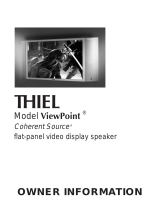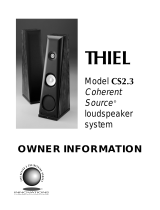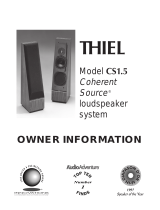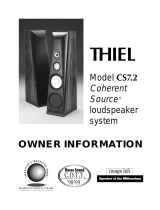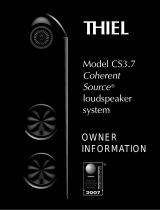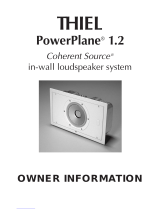
THIEL
Model
CS2.2
Coherent
Source@
loudspeaker
system
OWNER
INFORMATION

Congratulations
on
your
purchase
of the
THIEL model
CS2,2
loudspeaker system. It is
the
result
of a lon-e
and dedicated
eflort to
provide
verv
accurate
music reproduction. We have used
only the
highest
quality
components
and taken
great
care in its construction. Properly
set
up and used
with good
associated
equipment,
the
CS2.2s
will provide
vou
with
a
great
deal
of
musical enjoyment
for
many
years.
Speaker
Placement
The
CS2.2s
are relatively non-critical to room
piacerrent
and
will
provide good
results fiom
alrnost anywhere.
However.
here
are
some
guidelines
to help
vou
achieve the best
sound ll'clrn rour speirkers.
Speakerplaccrrent
will
atlect the accuracv o1'tirnbre.
spatial
perfbrmance.
and bass
pertbrmance.
Distance fiom rvalls:
THIEL
speakers. ancl
most
others.
souncl
best
rt they
are
placecl well
away
fronr
all
walls.
Such
placement
optimizes
imaging and depth. ancl musical tirlbres are
leproducecl u'itlr the least
coloration
because it
allows
the initial
sound
corning
from the speaker to be distinctly
separatecl in
time
frclrn
the
se,-'ondary sound of wall reflections. lf reflections
are
hearcl
too
clurckly
after the
prirrary sound.
1'our
brain tends to
interpret
thenr irs
part
of
the initial sound.
causins the
pefceived
timbre to
be altered and
the spatial chafacteristics to be confused.
THIEL speakers
will
sound best
when
placeri
at
least
one
tbot from:he back
wall
ancl at least
3
f'eet fiom the sicle wall. We like
to see the speakers
three f'eet fiom the rear
u'ail
ancl five f'eet tiom the
side wall. If
1'ou
experiment,
)'ou
u'ill notice
a major'
improvement in openness
when
the
speakers are even two t'eet tiom the rear
wall
instead of one. Also. it is not dcsirable fbr lar-se
objects to be
placed
near
the
spcakers since these
will
also be a source of unwanted early
reflections
that reclr.rce imaging
dccuracy.
Spacing:
Because of their
verv wicle.
even
ciispersion
of energy.
I'HIEL speakers should usually be
placetl
fnrthcr apart than
most. Optimum irlaging
is
usually achieved
when the speakers and th,: listener form an equilateral triangle. although this will
depend
on the
width
of the room-a
narrow room will recluire
closer
placeme
nt. If the spetrkers are too far apart fur
a
given
environment,
there
will
tend tcl be a
"hole"
in
the
rriclclle
of the sound
jta-ee:
if they are too close togethcr. thc irlage will
be
compressed
and will not achieve optimum
u'idth.
Aiming:
We
usually
pref'er
the
imagin-e
obtained
when
the
speakers are
pointed
straight ahead rather than
pointing
toward the
listener. This
placement produces
the
largest. most rratural
soundstage
However. toeing the speakers in somewhat rnay
produce
more specific
placements
of instruments. Also,
if it is
not
possible
to
.cet
the speakers
far enough
away
from
the sicle
walls,
a toed-
in
position
can
be helpful to reduce the strength of
wall reflections.
Bass:
Bass response is also afl-ectecl by speaker
placement.
In
generirl. when
a speaker
is close
to a
wall
the bass
response is
stl'onger ancl
placing
a speaker in a corner will make it even more so.
ln
order to achieve
properly
balanced bass.
it is necessary
for the speaker to be used
in the environment lor
which
it
was
designed. THIEL speakers are designed to
provide
accurate bass
when
positioned
away
fiom
all
walls-the same
position
that
provides
the best imaging.
Listener
position:
The CS2.2s
provide
broad dispersion of energy at all
frequencies ancl therefbre
provide good
results
throughout
a large listening area.
Best imaging is
provided
fbr
a
listener centered in fiont of the
speakers.
Optin'rum
phase
and
time alignment
is
provided
only
for
a seated
listener who is
eight or
more f-eet arvalr l-rorn the speakels.
and e.rperimentntiort
is necessctrt' to achieve
the bcst rcsults.
Connecting
the Speakers
The CS2.2's
input ten.r.rinals are located on the bottom of
the speaker. To
gain
iiccess to
these
the
speaker should be
laid on its back or side.
Muke
sure that all
(
ontrc(ti()ns dt
(
tight.
It is essential
fbr
proper perfbrmance
that both speakers
in
a stereo
system be
wired
in the same
polarity.
The
speaker's input terminals are
color
coded
to facilitate this.
The wire
connected
to the red input terminal of each
speaker should connect
to the respective
positive
output
terminals of the amplifier: the
wire
connected
to the black
input tenninals
should be connected to the
respective
negative output terminals of the amplifier.
The speakers should be connected to the
amplifier with
high
quality
cable
to ensure minimal loss of
power
and
proper
control by
the amplifier. lf the speakers are being
connected to a
vacuum
tube
amplifier
with various
impedance taps,
the
ul
ohm tap
will
usually
give
the best
results.
Bottom
View
of
Speaker

Stabilizer Pins
Speakers
positioned
on
a soft surface
such
as carpetin-s
are
able to rock
back ancl fbrth
slightly
and will
vibrate
in reactron
to
those tbrces
the speaker
-qenerates
to move
the driver
ditrphra-ems.
(Evt:rv
action
has an
equal ancl
opposite
reaction.)
This
speaker
motion
causes a loss
of
rnusical
infbnnation
and reduces
the
claritv
of
rhe
music.
To elirninate
this etfbct.
the THIEL
CS2.2
can
be used with
the
provrded
stabilizer pins.
The
pins
are
pushed
into
three
pre-
drilled holes
in tlle base
of
each speaker.
The
point penetrates
the
carpt't and
allows the
speaker
to rest firntly
on
the floor
underneath.
The three
pins
provide
a stable
foundation which
eliminat('s
some
obscuring
of infbrmation
and
procluces
a
cleaner.
more
articulate
souncl. No pins
are required when placing
the
speakers
on hard
or smooth surfaces.
There
are some applications
where
the
stabilizerpins
will nof
improre
the sound
but ma1,
actuallv
make it worse.
This situation
occurs when
the f-loor itself
is not
rigid
iind therefbre vibrates
when
connected
to the speakers
via
the stabilizer pins.
We
encourage
you
to expenment
to determine
whether
or not
this is
the case.
We
recommend
that
you
determine
the
position
of
your
speiikers
befrtre inserting
the
pointed
stabilizer pins.
To insert
the
pins.
tiltthespeakerfbrwardandpushthetwobackpinsiullyintothe
["det:pholeslocateclineachbackcorner-otthebase.Thenrock
the
speaker backrvard
and insert
the fiont pin.
Finallv. press
finnly
on
rhe
top
of the speaker
with
a slight
rocking
motion
until
the
pins penetrate
the calpet
completely.
To
check thtrt
the
pins
are finnly
seated.
tap the back
irnd side
of the
speaker. There
should
be no movement
and
the
speaker
should
f'eel
solidlv irr pltrce.
if
the speaker is
tnoved with
the
pins
in
place.
care
should
be taken
to
lift
the
speakers straight
up
until the
pins
have
cleared
the
calpet. AIso,
tilting
the speaker
so it's weight
is resting
on any single pin
can
dana-ee the
speaker's
wood
base.
Please
be cautioned
that
the
pointed
pins
can
be dangerous
if
not used with
care. They
can
cause small
dents
in hqrd,,lood
floors
and it is
possible
to
damage carpets
if the
speakers
are movecl
incorrectly
with
the
pins
in
place.
Associated
Equipment
The
CS2.2
is
a
very
high quality
sound reproducer
and
will
benefit fiom
use with
the best
associatecl
equiprnent.
Since
ir is
extremely
accurate. it will
reveal
sources of distortion
generated
elsewhere in
the system. For
example,
distortion resuiting
fiom
poor
recordings
or inferior
electronics
will
be reproduced
accurately.
Also.
the
quality
of the interconnect
cables
and
speaker
cables will
significantly
affect the
perfonnance
of the
system.
Power
Requirements
It is important
to have
enough
power
to
play
at the level you
desire without
distortion.
If high
sound
levels
are desired,
the
CS2.2s
are designed
to be used with
amplifiers rated
up
to 250 watts
perchannel.
If
you play
the
speakers
more loudly
than
the
volume
the
arnplifier can
cleanly
produce,
the
amplifier will produce
overloacl
(clipping)
clistortion.
This
clistortion
is actually
non-musical
adtlitiottul
energv and
since it is
concentrated
in the
high frequency
region
where
the speaker is
least
able to handle
it, tweeters
can be
darnaged in
extreme
cases.
Keep in mind
that soundclLrctlitt
is
usually much
more
important
than sound
cluantitt'. There
can
be large
differences
in
the sonic
peformance
of two amplifiers
of
equal
power,
and this is
more important
thern large
dif-ferences
in power.
Most
everyone
will
be
happier with
a 50 watt
amplifier of high
sonic
quality
than
with a 200 u,att
amplifier
of mediocre
sonic
quality.
For
this reason,
we
feel
there is no substitute
tbr listening
to make your
amplifier
decision.
The question
"how
much
power
do I need?"
does not have
a simple
answer because
it is not
determined
only by the
loudspeaker's
etficiency, but
also by
the
volume
desired
and the size
o1 the room.
If all three
factors
are average,
about
-50 watts
per
channel is required.
Each
factor
can raise
or
lower
this amount
by about
three times.
I
)
Usually,
people
who
"don't
like music
loud"
can decrease
their
porver
to
about one-half.
People
who like
music
loud
should
increase
their
power
by two times
or more. Most people
lall within
a normal
range.
2) A
speaker with
a
low
S4dBAV-m
efficiency
will
require
twice the
power
of
an average 87dBAV-m
speaker.
A speaker
with
a
high
90dBflil-m rating
will
require
only half
the
power
of an average
speaker.
The CS2.2 is
of average
efficiency
(86dB)
and
therefore
requires
an average amount
of
power.
3)Asmall
roomwill needlesspowerfbragivenloudnesslevel
than.rlargeroom.Averysmall
roomof
l000cuft(ll'x
ll'
with
an 8' ceiling) will require
about
half the
power
of an average
size room. A
lar-ee room
of 6000
cu ft
(20'
x
30'
with
a l0'
ceiling) will require
twice the
avera-qe
power.
If the listening
room
is
connected
to another room
by
a
large
open
area,
the required
power
will increase.
but not
by the the
amount
of the cornbined
room vrtlume.
With
all this in rnind.
a
person
who
doesn't
like to play
music very
loudly
and has
a small room
can
get
high
quality
sound with
only 20 watts. whereas
a
person
who
sometimes Iikes
to play
loudly
in a large room
may need
250 watts.
Cabinet Finish
Care
THIEL wood cabinets possess
a high quality
lacquer
finish
that is
both beautiful
and durable.
However,
any
wood
finish
can be
damaged
by excessive
moisture,
dryness,
or direct
sunlight. When
cleaning
your
speakers.
avoicl
using
oils,
waxes
or
polishes
that
contain silicone,
such as Pledge
or Johnson's. We
recommend
using Endust.
If'
y.ou
ov,rt a
gloss
black
lacquet-
speaker.
Ttlease
refer to
the instuttions
inL'luded with
its spec,ial
cabinet
care kit.
The
grilles
can be cleaned
ofdust
by using an
upholstery
attachment
ofa vacuum
cleaner.

Grille
The CS2.2
grille
is designed as an integral
part
of the system
to reduce unwanted diffraction effects. If
you
wish
to
temporarily remove the
grille, pull
the bottom of the
grille
frame
away
from
the speaker an
inch
or so and then lift the
grille
upward to
remove it. When replacing
the
grille,
first
push
the top down onto the baffle and then
push
the bottom
back.
Service
If
your
system requires service.
contact
your
authorized
THIEL dealer. If
you
need to contact the factory, service
information and technical support is
available at
(606)
254-
9421
,Monday-Friday,
8:30 a.m.- 5:00
p.m.
Eastem Time.
We
Want
You Listening For A Lifetime
Removing
the Grille
Used wisely,
your
new sound equipment will provide
a lifetime of enjoyment. Since hearing
damage from loud noise is
often
undetectable until
it is
too
late, THIEL
and the Electronics Industries ,\ssociation's
Consumer Electronics
Group
recommend you
avoid
prolonged
exposure
to
excessive
noise. Depending
on room size and amplifier
power,
some home audio systems
can reach
sound
pressure
levels in
excess of 90 decibels
with peaks
of over a 10() decibels. For
your protection,
the list below identifies
sound
levels for various noises.
\
Decibel
Level Examnle
30
Quiet
library,
soft
whispers
40 Living room, refrigerator,
bedroom away
from
traffic
50 Light traffic, normal conversation,
quiet
office
60 Air conditioner at 20 feet, sewing machine
10
Vacuum
cleaner,
hair
dryer,
noisy restaurant
80
Average
city
traffic,
garbage
disposals, alarm clock at
two feet
The Following Noises
Can
Be Dangerous
Under
Constant Exposure
90 Subway,
motorcycle,
truck traffic, lawn mower
100
Garbage truck, chain saw,
pneumatic
drill
120 Rock
concert
in
front of
speakers. thunderclap
140
Gunshot blast,
jet
plane
150 Rocket launching
pad
Inf<lrmation courtesy of the Deafness
Research Foundation and the EIA.
LIMITED WARRANTY
THIEL
warrants
every
THIEL
model CS2.2 system against defects in materials
and
workmanship
to the original
owner for a
period
of ten
years
from the date of
purchase.
THIEL will,
at
no
charge,
replace
any defective
part
and make
any
repairs
neces-
sary to ensure its
proper performance
when the defective unit is retumed to
us
postpaid.
This warranty does not cover
damage due to accident or abuse and
is void
if the unit has been tampered with.
This
warranty is
automatic and no registration is required. This warranty
gives you
specific
legal
rights. You may
also have
other rights which are
particular
to
your
state.
The following information is for
your
records.
Serial
Numbers
Purchase Date
Purchased From
THIET
'l
026
Nandino Boulevard
Lexington,
Kentucky 4051 1
-1
207
wd(
You
LISTENING
/
